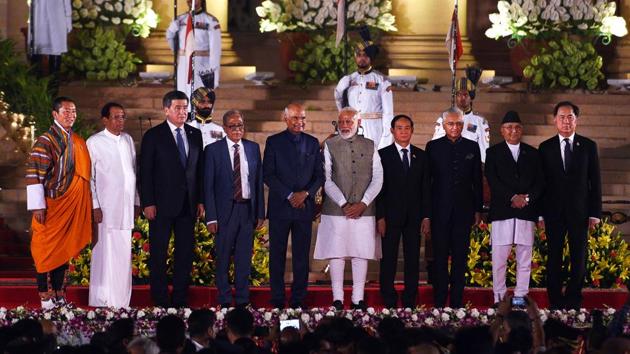Neighbourhood first: Capacity needs to match the commitment
Failure to deliver on commitments has begun to affect New Delhi’s reputation and, in some cases, perversely incentivised neighbours to further deepen their outreach to China
New Delhi has made extraordinary efforts to reconnect with the region in recent years. Under the “neighbourhood first” policy, the mindset changed positively towards connectivity and Prime Minister Narendra Modi’s outreach to leaders from Bimstec (Bay of Bengal Initiative for Multi-Sectoral Technical and Economic Cooperation) countries for his swearing-in ceremony indicates that there is political will to keep prioritising the region and make further commitments. But beyond good intentions and commitments, India’s real test in the neighbourhood will be to expand its capacity to implement, open its economy, and stop reacting to Chinese inroads.

Slogans aside, credit is due to Modi’s political outreach to the neighbourhood since 2014. Before him, no Indian prime minister had visited Nepal and Sri Lanka on proper bilateral visits since the late 1990s and 1970s, respectively. When Pakistan obstructed India’s connectivity agenda at Saarc (South Asian Association for Regional Cooperation), New Delhi pragmatically moved on to cooperate with like-minded neighbours under Bimstec and BBIN (a sub-regional grouping of Bangladesh, Bhutan, India and Nepal).
Land boundary and shipping agreements were finally concluded with Bangladesh, which hosted the first-ever visit of an Indian defence minister in 2016. India also became a net electricity exporter to its neighbours and opened four new Integrated Check Posts (ICPs) to facilitate cross-border trade, with 13 more planned on the borders with Nepal, Bangladesh and Bhutan.
Such initiatives reflect a new focus on the periphery and a growing understanding that Indian economic and security interests can only be achieved through greater regional integration. Even if only belatedly, reacting to China’s sudden appearance in the neighbourhood, New Delhi seems to have finally woken up to connectivity as a strategic imperative. Paradoxically, however, “neighbourhood first” has also exposed tremendous capacity deficiencies. Whether it is the ministry of external affairs (MEA) or several line ministries, the bureaucratic machinery has been struggling more than ever to realise Modi’s bold commitments to neighbours on the ground.
India’s first and foremost challenge will, therefore, be to bridge the growing gap between increasing political commitments and its stagnant administrative capacity to follow up. India will continue to underdeliver until it expands its capacity to implement. Nowhere was this more apparent than in 2016, when Modi announced Bimstec as a priority even while it took India two years to depute its director to the organisation’s secretariat. Failure to deliver on commitments has thus begun to affect New Delhi’s reputation and, in some cases, perversely incentivised neighbours to further deepen their outreach to China.
To reduce this implementation gap, India must start to massively expand its diplomatic cadre at the MEA but, at the same time, also curtail its role as an international gatekeeper. Other ministries, the armed forces and state governments must be given greater autonomy to directly engage with their cross-border counterparts. Another way to speed up implementation would be to appoint a cabinet-ranked prime minister’s special envoy on regional connectivity, with political clout to reach out directly to leaders in neighbouring capitals and overcome bureaucratic hurdles.
Second, as the subcontinent’s predominant power, India’s investment in connectivity will only succeed if there is also economic openness. However much it may hurt, Modi will have to invest political capital for India to lead by example and open up its economy to the neighbours. He alluded to this in 2018, when he emphasised that “India is ready to work as the Sherpa for Nepal”. This may be easy to say, but to concede asymmetric advantages to neighbours will be costly, both at home and abroad, where cross-border mobility will affect protectionist interests and demographic balances. Political leadership will be required to sustain positive discrimination towards Indian neighbours as a strategic investment in interdependence.
This can be pushed through, for example, by eliminating all bureaucratic, tariff, security and any other barriers to trade and transportation between Nepal, Bhutan and Bangladesh through Indian territory. Another would be to adopt the pending Bimstec free trade agreement. In several other areas, New Delhi will fail to connect unless it concedes. Why should Nepal keep begging for more air transport corridors across India or keep its border open according to an outdated bilateral treaty from 1950? And why should the Maldives refrain from further trade liberalisation with China, if India is not able to offer better terms?
Finally, India will have to regain the initiative over China, which is now a resident power in South Asia, whether through its optic fibre connecting Nepal across the Himalayas; the 99-year lease of Sri Lanka’s Hambantota port; or its shareholding in the Dhaka Stock Exchange. While adjusting to Beijing’s growing influence in its backyard, India has often oscillated between the extremes of hopeful inaction, waiting for Chinese initiative to fizzle out, and obsessive obstruction of Chinese projects as alleged security threats. Beyond such short-termism, New Delhi must invest in ways that can shape neighbouring countries’ long-term incentives to connect with India first.
This will require more focus on capacity-building programmes that increase technical self-sufficiency and institutional resilience in neighbouring countries. Let China pay for hard connectivity, and instead explore India’s comparative advantage in cross-border infrastructure, soft connectivity and democratic governance. India will also have to prioritise trilateral partnerships with like-minded Indo-Pacific powers, especially Japan and the United States but also the European Union, if it wants to offer reliable alternatives to China. Finally, if it is serious about regional cooperation beyond just Bimstec, New Delhi will also have to recommit to Saarc to avoid its own diplomatic isolation in the region.
Constantino Xavier is a fellow at Brookings India, New Delhi
The views expressed are personal



